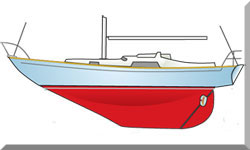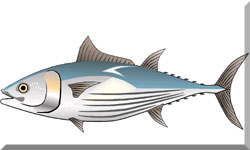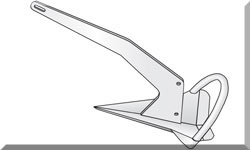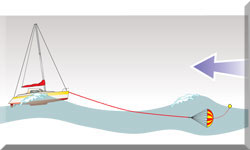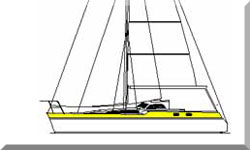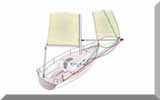- Home
- Hustler Sailboats
Hustler Sailboats: Great Boats from a Bygone Era
Walk into any marina, and you'll spot them – those sleek, powerful boats bearing the "Hustler" name, typically designed for raw speed on the water.
But if you know where to look, a different kind of Hustler story unfolds, one steeped in the rich history of British boatbuilding. Forget the roaring engines; these are the Hustler sailboats, elegant and capable vessels from an earlier time.
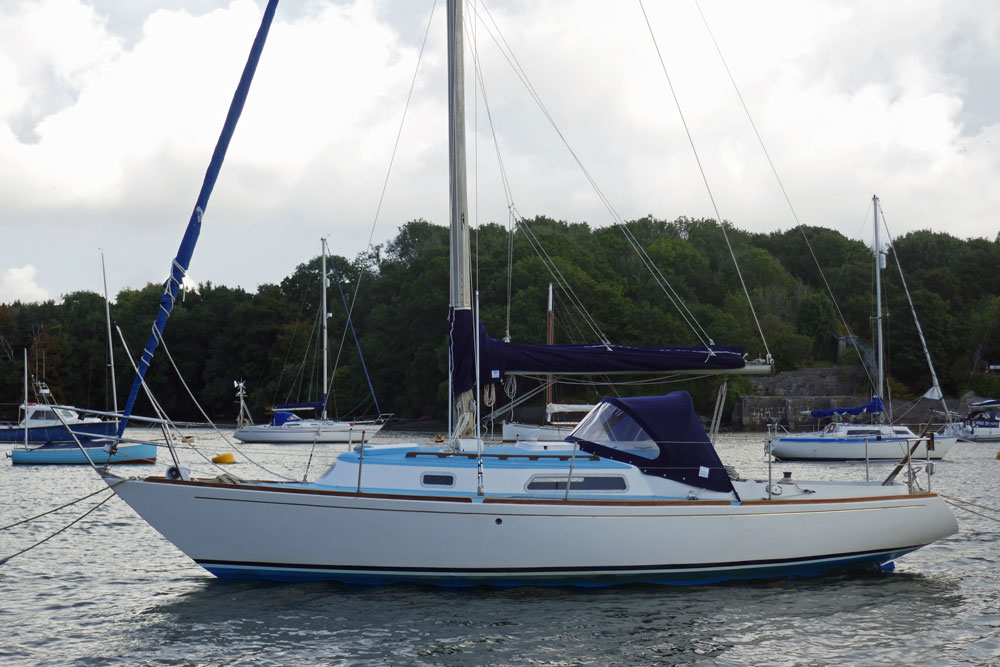 Hustler 30
Hustler 30They're not about flashy modern design, but about thoughtful craftsmanship and rock-solid construction. They’ve quietly built a reputation as seaworthy cruisers and surprisingly nimble racer-cruisers, continuing to captivate sailors who appreciate a boat built right. If you're sifting through options, maybe eyeing Hustler sailboats for sale or simply plain curious, settle in.
Where It All Began: A British Boatbuilding Story
The sailing yachts that proudly wore the "Hustler" badge actually sprang from a lively period in British boatbuilding, a world away from the later American powerboat ventures. Their story is deeply entwined with two highly regarded UK firms: Tyler Boat Company and Landamores Yacht Builders. Tyler, which got its start in 1958, became the go-to specialist for fiberglass hulls. Landamores, meanwhile, with roots stretching all the way back to 1923, was renowned for its top-notch woodworking and overall boatbuilding artistry. This powerful combination, boosted by the brilliance of outside naval architects, truly defined what a "Hustler" sailboat would become.
The main idea behind these early Hustler sailboats was beautifully straightforward: build boats that weren't just thrilling to sail, but also provided a strong, comfortable platform for anything from coastal hops to more ambitious offshore trips. This unwavering commitment to both exhilarating performance and undeniable safety shines through in every curve and joint, highlighting balanced handling and seriously tough construction.
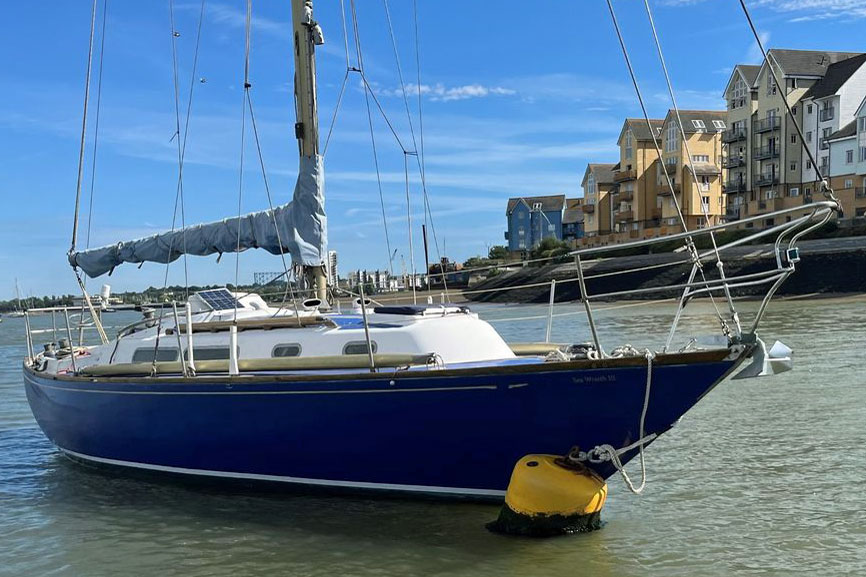 Hustler 35
Hustler 35The Visionaries and Their Standout Designs
Take a good look at a Hustler sailboat, and you'll immediately see the elegant, purposeful lines that are a signature of their designers. A giant in this field was the highly respected British naval architecture firm, Holman & Pye, founded by Kim Holman and Donald Pye. These two were the brains behind the incredibly successful Hustler 30 and the initial Hustler 35. Later, the exceptionally talented Stephen Jones lent his genius to the lineage, particularly with the Oyster SJ35 (sometimes fondly referred to as a Hustler SJ35 or Verl Hustler 33), a true gem from the International Offshore Rule (IOR) era, masterfully blending competitive racing spirit with comfortable cruising amenities. It's no wonder these particular Hustler sailboats remain so highly regarded.
Generally speaking, Hustler sailboats share some distinctive design traits that make them stand out:
- Fin Keel and Skeg-Hung Rudder: This was a popular setup for performance-oriented cruiser-racers of that time, striking a nice balance between nimble maneuvering and tracking straight. The Hustler 30, for instance, sports a fin keel with a skeg-hung rudder, though a shallow fin keel was an option on some. The original Hustler 35 also featured a fin keel with a rudder on skeg.
- Moderate Beam and Solid Build: Unlike today's wider, more voluminous cruisers, Hustler sailboats, especially the Hustler 30 and Hustler 35, are relatively slender. This gives them a classic, appealing profile and often translates to a gentler ride in choppy seas. While they might not be the fastest in light breezes, their moderate-to-heavy displacement (the Hustler 30 is particularly robust) adds significantly to their stability and offshore capability.
- Masthead or Fractional Sloop Rigs: These were the standard, reliable sail plans for performance yachts of the period, offering good versatility. The Oyster SJ35, in particular, boasted a twin-spreader fractional rig, allowing for precise tuning to maximize performance.
Among the various Hustler models, a couple truly shine and have cemented their place in sailors' memories:
- Hustler 30: Launched in 1970, this boat very quickly earned a stellar reputation. Tyler Boat Company and Landamores built 84 of these beauties up until 1976. Owners consistently rave about her balanced helm and her willingness to carry a good press of sail even when it's blowing hard, powering through waves with surprising grace. She's not a light-air flyer (her Sail Area/Displacement ratio of 14.8 is quite conservative), but her deep-seated stability, thanks to a healthy Ballast/Displacement ratio of 47.3, makes her a genuinely seaworthy and comfortable companion for longer journeys. This is a boat that truly comes alive when the wind kicks in. If your priority is seaworthy sailboats, the Hustler 30 absolutely deserves your attention.
- Hustler 35 / Oyster SJ35: The original Hustler 35, designed by Donald Pye, saw about 45 units built by Tyler Boat Co. between 1971 and 1979. This was a classic fin-and-skeg, masthead sloop. However, it's the Oyster SJ35, penned by Stephen Jones, that truly shot to legendary status. Built by Oyster Marine/Landamores (27 were launched between 1983 and 1985), this yacht was a formidable ¾ Tonner. She racked up an impressive string of offshore race victories, including a class win in the Fastnet Race and an overall win in the Channel Race in 1983.
The SJ35 Imperator was even crowned RORC Yacht of the Year in 1988 and repeated her Fastnet class win in 2001. Being relatively light for her size with a large, highly tunable fractional rig, the SJ35 masterfully blended race-winning performance with comfortable cruising accommodations. Many who search for Stephen Jones yachts are captivated by this model. And let's not forget the Verl Hustler 33, another clever Stephen Jones design derived from the successful Half Ton racer, the Hustler 32, known for its superb sailing characteristics in all conditions – light or strong winds – and for being remarkably seaworthy and easy to handle.
As yacht design naturally moved forward, the Hustler series evolved too. We saw a gradual shift from older, more traditional long-keeled forms towards the fin-and-skeg or fin-and-spade configurations, aiming for that sweet spot of improved performance while staunchly upholding their core values of strength and reliability.
Built Tough: Construction Quality You Can Trust
Hustler sailboats were simply built to last. This unwavering commitment to quality was a hallmark of British boatbuilding from that era. Their hulls and decks were primarily crafted from GRP (Glass Reinforced Plastic), more commonly known as fiberglass. While super-advanced methods like vacuum infusion were still rare, the skilled craftspeople meticulously applied hand lay-up techniques, prioritizing sheer strength and durability. This robust GRP construction is a big part of why they've held up so well.
The undeniable fact that so many Hustler sailboats are still out there actively sailing today speaks volumes about their tough construction. Owners consistently praise their structural integrity and their ability to shrug off even challenging conditions. Of course, like any boat that's seen a few decades, prospective buyers should absolutely expect some typical wear and tear that comes with age. Some Hustlers might have been "owner-completed" (meaning the original buyer finished the interior themselves) or undergone various levels of refit over the years. This can lead to quite a bit of variation in interior finish and overall care from one boat to the next. So, a comprehensive survey is, without a doubt, an absolute must for anyone serious about acquiring one of these classic beauties.
How They Sail and What They Feel Like Inside
Ask a Hustler owner about how their boat performs under sail, and you'll almost certainly hear a chorus of praise. These yachts, especially the Hustler 30 and Hustler 35, are frequently described as:
- Balanced and Easy to Handle: Sailors often talk about a smooth, sea-kindly motion and a direct, satisfying feel at the tiller or wheel. The skeg-hung rudders on models like the Hustler 30 offer excellent straight-line stability, while the spade rudder on the SJ35 provides impressive agility.
- Stable and Stiff: Thanks to their generous ballast, Hustler sailboats stand up admirably to their canvas, letting them carry sail effectively even when the breeze is stiff. This inherent stability translates into a comfortable ride in choppy seas, making them truly well-suited for offshore adventures. The Hustler 30's remarkable 47.3% Ballast/Displacement ratio really underscores this stiffness.
- Good Upwind Performance: They've earned a solid reputation for sailing efficiently into the wind, which is a vital trait for both serious cruising and competitive racing.
While the Hustler 30, for example, might not win any speed contests in whisper-light airs, her ability to maintain a steady pace and provide a comfortable trip in varied conditions makes her an excellent choice for genuine cruising. The Oyster SJ35, on the other hand, clearly designed with an eye on the race circuit, consistently delivered on the performance front, proving the strength of Stephen Jones's designs. Indeed, the Hustler 30 can comfortably manage around 6 knots in moderate winds, even pushing 8 knots when the breeze strengthens, all while handling rough seas with ease. Many would say these cruiser racer sailboats truly offer the best of both worlds.
Stepping below deck, the interiors of Hustler sailboats from the 1970s and 80s perfectly reflect the design sensibilities of their time. Generally, you'll find:
- Classic Look: Expect warm, classic marine woodworking, often in teak or similar rich woods, creating a cozy and inviting atmosphere.
- Practical Layouts: While their narrower beams might make them feel a bit snug compared to today's expansive interiors, the layouts are typically very practical and cleverly designed to make the most of every inch for sleeping, cooking, and navigation. The Hustler 30, for instance, offers a sensible 4-berth arrangement with a dedicated toilet compartment and a functional galley. Even the Verl Hustler 33, theoretically sleeping seven, is most comfortable for four or five on extended trips.
- Focus on Sea-Going Use: Interior design often prioritized secure handholds and efficient use of space, reflecting a practical approach to offshore conditions rather than open-plan extravagance. You'll usually find a surprising amount of well-placed storage for a boat of their size.
Thinking of Buying a Hustler: What to Check
If you're seriously considering adding a pre-owned Hustler sailboat to your maritime family, here are a few key points to keep in mind:
- Engine Condition: Given their age (many were built in the 1970s and 80s), the engine's condition is often the most critical factor. Many original engines might be due for replacement or a significant overhaul. For example, the Hustler 30's offset propeller is a known quirk that might take a little getting used to when maneuvering under power. Interestingly, some Hustler 30s have even been modernized with electric motors and extensive solar arrays, showing just how adaptable they are.
- How it was Finished/Refitted: While the basic hull moldings are undeniably strong, remember that some Hustlers might have been "owner-completed" or undergone various levels of refit over the years. This means the interior finish and overall care can vary considerably from one boat to the next. A thorough marine survey, meticulously checking the standing rigging, sails, and through-hull fittings (which, on a well-maintained example, may be recently replaced), is absolutely essential. If you're searching for used Hustler boats, consider a survey your best friend.
- Space Expectations: It’s important to adjust your expectations for interior room. These boats were designed with different priorities than modern, wider cruisers. They offer a seaworthy and comfortable experience, but certainly not the cavernous interiors of their newer counterparts.
- Resale Value: Good news! Well-maintained Hustler sailboats, particularly the Hustler 30 and Hustler 35, generally hold their value quite well within their niche. Their strong reputation for build quality and sailing performance makes them an attractive option on the used market, often serving as an accessible entry point for those seeking a classic, capable yacht. You'll find a fair number of Hustler 30s for sale in the UK, with prices reflecting their age and the care they've received.
A Continuing Story for Sailors
The Hustler series of sailboats, especially the iconic 30 and 35, truly holds a significant place in the story of British yacht building. They represent a design philosophy that strongly prioritized capable sailing performance alongside tough construction, resulting in boats that are not only a delight to sail but also profoundly trustworthy when faced with the challenges of the open sea. While the "Hustler" name eventually branched into the world of powerboats, the enduring charm of these earlier sailing yachts, conceived by visionaries like Holman & Pye and Stephen Jones, continues to deeply resonate with sailors looking for a classic, genuinely seaworthy, and engaging experience on the water.
They truly stand as proof of the lasting appeal of well-thought-out and carefully built yachts that cherish the very essence of sailing. While a formal, widely active owner's group might not exist for all Hustler sailboat models, informal online forums and the broader classic yachting communities often serve as vibrant places where owners exchange insights, share stories, and celebrate these respected vessels. Their continued presence in the water is a quiet yet powerful nod to their lasting impact on sailboat design and construction, having shaped a generation of British performance cruisers.
Recent Articles
-
Ohlson 38 Guide: Specs, Performance Analysis & Cruising Review
Jan 07, 26 05:52 AM
Discover the Ohlson 38 sailboat. An in-depth look at its Einar Ohlson design, Tyler GRP construction, performance ratios, and why it remains a top choice for offshore sailors. -
Passoa 47 Sailboat Review: Comprehensive Specs & Performance Analysis
Jan 04, 26 04:57 AM
Discover the Passoa 47, a legendary aluminium blue water cruiser by Garcia. Explore technical specifications, design ratios, and why its lifting keel is a game-changer for offshore sailors. -
Sailboat Wheel Steering Maintenance & Inspection Checklist
Dec 30, 25 02:32 PM
Keep your vessel’s helm responsive and reliable with our expert maintenance checklist. Master cable tensioning and system inspections to avoid mid-passage failures.


